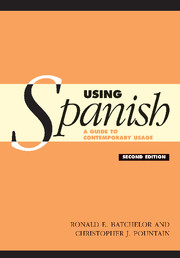Book contents
- Frontmatter
- Contents
- Authors' acknowledgements
- Preface to the second edition
- List of abbreviations and symbols
- Glossary
- The Spanish speaking world: countries where Spanish is spoken, with an estimate of the numbers of native speakers
- 1 Introduction
- 2 Passages illustrating register and local variety
- Part I Vocabulary
- 3 Misleading similarities between Spanish and English
- 4 Similarities between Spanish words
- 5 Fields of meaning – vocabulary extension
- 6 Complex verbal expressions
- 7 Affective suffixes
- 8 Idioms, similes and proverbs
- 9 Proper names
- 10 Adjectives pertaining to countries and towns
- 11 Abbreviations
- 12 Latin expressions
- 13 Anglicisms
- 14 Grammatical terms
- 15 Interjections
- 16 Fillers
- 17 Transition words
- 18 Numerals
- 19 Measurements
- 20 Semi-technical vocabulary
- Part II Grammar
- Index
10 - Adjectives pertaining to countries and towns
Published online by Cambridge University Press: 05 June 2012
- Frontmatter
- Contents
- Authors' acknowledgements
- Preface to the second edition
- List of abbreviations and symbols
- Glossary
- The Spanish speaking world: countries where Spanish is spoken, with an estimate of the numbers of native speakers
- 1 Introduction
- 2 Passages illustrating register and local variety
- Part I Vocabulary
- 3 Misleading similarities between Spanish and English
- 4 Similarities between Spanish words
- 5 Fields of meaning – vocabulary extension
- 6 Complex verbal expressions
- 7 Affective suffixes
- 8 Idioms, similes and proverbs
- 9 Proper names
- 10 Adjectives pertaining to countries and towns
- 11 Abbreviations
- 12 Latin expressions
- 13 Anglicisms
- 14 Grammatical terms
- 15 Interjections
- 16 Fillers
- 17 Transition words
- 18 Numerals
- 19 Measurements
- 20 Semi-technical vocabulary
- Part II Grammar
- Index
Summary
Spanish has a wealth of special adjectives for inhabitants of countries and towns. By contrast with similar adjectives in English (Mancunian, Liverpudlian, etc), the Spanish ones are in extremely common use. It is difficult to predict which of the several suffixes available will combine with a particular name, and sometimes the adjective will be unrelated to the name, or derive from an older name.
The following list includes the commoner of these adjectives, and those which are not immediately recognizable.
España → español or hispano (R3)
NOTE the use of hispano- in compounds, eg hispanoárabe.
note: Spain is frequently referred to as la Península(peninsula), especially when distinguishing between the mainland and Baleares and Canarias.
Regions
Andalucía → andaluz
Aragón → aragonésormaño/mañico (R1)
(las Islas) Baleares → balear
(las Islas) Canarias → canarioorguanche
note: The Canaries are also referred to simply as Las Islas.
Cantabria → cántabro
note: la Cordillera Cantábrica, el Mar Cantábrico
Castilla → castellano
Cataluña → catalán
Extremadura → extremeño
Galicia → gallego
el País Vasco → vascooreuskadi (invariable), the latter preferred by Basques
note: Vascongado is used chiefly in the expression las Provincias Vascongadas. Vascuence is used for the Basque language (also euskera).
Towns
Alcalá de Henares → complutense
note: complutense is also used of the Madrid University which was transferred from Alcalá.
Ávila → abulense
Barcelona → barcelonés
note: Barcelona is also frequently referred to, especially in journalistic R3, as la Ciudad Condal.
[…]
- Type
- Chapter
- Information
- Using SpanishA Guide to Contemporary Usage, pp. 213 - 219Publisher: Cambridge University PressPrint publication year: 2005



